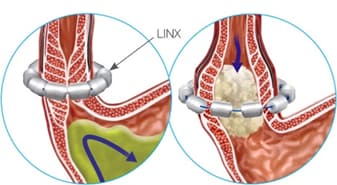Heartburn (Acid Reflux)
The Midwest Institute for Robotic Surgery at Silver Cross Hospital is a leader in Gastroesophageal Reflux Disease (GERD) surgery.
Heartburn or acid indigestion is a painful, burning feeling that may radiate to the neck, throat, or angle of the jaw. If you have heartburn more than twice a week, you may have GERD.
 GERD
GERD
Gastroesophageal reflux disease or GERD occurs when stomach acid flows back into your esophagus (tube from the mouth to the stomach) and irritates the lining. GERD can occur when your lower esophageal sphincter (valve between your esophagus and stomach) weakens and causes stomach contents to rise (reflux). The most common symptoms of GERD are frequent acid reflux and heartburn. Other symptoms may include:
- Asthma
- Chest pain
- Dry cough
- Food that feels stuck in chest
- Multiple cavities and erosion of teeth
- Nausea
- Pneumonia
- Regurgitation
- Vomiting
- Wheezing
GERD is sometimes caused by a hiatal hernia which occurs when part of your stomach moves up toward your diaphragm or chest. Other causes of GERD may include:
- Certain medicines
- Obesity
- Pregnancy
- Smoking or second-hand smoke
Most people can manage their GERD symptoms with lifestyle changes and/or medicines, while others may need surgery.
GERD Repair Options
 If your GERD symptoms are severe and cannot be eased with medicine or lifestyle changes, your doctor may suggest surgery. Surgery for GERD is called fundoplication or Nissen fundoplication. During GERD fundoplication surgery, your doctor wraps the upper curve of your stomach (fundus) around the esophagus (tube that carries food and liquids from your mouth to your stomach). Your surgeon will then stitch it into place. This strengthens the valve between your esophagus and stomach, which stops acid from rising into the esophagus as easily.
If your GERD symptoms are severe and cannot be eased with medicine or lifestyle changes, your doctor may suggest surgery. Surgery for GERD is called fundoplication or Nissen fundoplication. During GERD fundoplication surgery, your doctor wraps the upper curve of your stomach (fundus) around the esophagus (tube that carries food and liquids from your mouth to your stomach). Your surgeon will then stitch it into place. This strengthens the valve between your esophagus and stomach, which stops acid from rising into the esophagus as easily.
Your doctor may use open surgery or minimally invasive surgery, which includes traditional laparoscopy or robotically-assisted surgery.
Open Surgery
During open surgery, a large incision (cut) is made in your abdomen. This allows doctors to reach your organs as they operate.
Minimally Invasive Surgery
During minimally invasive surgery, also known as laparoscopy, your surgeon operates through a few small incisions using long, thin instruments and a tiny camera that guides doctors as they operate. Another minimally invasive surgery option is robotically-assisted da Vinci® Surgery.

da Vinci Surgery Option
The robotic da Vinci Surgical System is a minimally invasive option that requires significantly smaller incisions. The potential benefits of controlling acid reflux disease include:
- Fast recovery time
- Fewer complications
- Less scarring
- Low risk of the GERD returning
- Minimal blood loss
- Reduced pain; especially when performed using the da Vinci® XI
- Shorter hospital stay
If your doctor suggests surgery for GERD and its symptoms, ask about minimally invasive da Vinci Surgery.
Using a da Vinci® robot, the surgeon makes a few small incisions in the abdomen using long, thin instruments and a tiny camera. The camera sends images to a video monitor in the operating room to guide your surgeon during the operation. The robot is designed to provide surgeons with enhanced capabilities, including high definition 3D vision and a magnified view. Your doctor controls the robot, which translates his or her hand movements into smaller, precise movements of tiny instruments inside your body. The robot cannot act on its own. Surgery is performed entirely by the surgeon.
In many cases, surgery can lead to long-term control of acid reflux. If a hiatal hernia is causing GERD symptoms, your surgeon may also repair the hernia during this operation. Talk to your doctor to decide if robotic surgery is right for you. As with any surgery, there are risks.
LINX Device for Treating Chronic Heartburn/Reflux

LINX is a revolutionary solution for reflux and heartburn; the LINX device is similar to a beaded bracelet; it’s a flexible ring of magnetic beads placed laparoscopically around the base of the esophagus to help keep the stomach valve closed and prevent reflux from occurring.
LINX is a permanent, drug-free treatment for GERD that helps prevent gastric acids from pushing back up into the esophagus from the stomach, yet also allows the lower esophageal sphincter (LES) located at the base of the stomach to open when required to allow for easy swallowing.
When a person with the LINX system swallows, the motion of food or drink passing through the lower esophagus overcomes the magnetic attraction between the beads, permitting the contents to pass through the LES into the stomach. When the stomach reacts and reflux tries to escape up the esophagus (which would then result in heartburn), the magnetic beads keep the acid down in the same manner as a normally functioning LES. The LINX procedure can help patients return to a normal lifestyle unaffected by GERD.
Best of all, the LINX implant was designed to be a lifelong solution to acid reflux.
Patients who undergo this surgery are allowed to eat regular food that same day and typically go home the same day or the next.
In 2017, Silver Cross became the first and only hospital in Will County to offer the LINX implant.
To be affiliated with the Midwest Institute of Robotic Surgery at Silver Cross Hospital, surgeons must meet rigorous criteria and demonstrate excellent outcomes and high patient satisfaction.